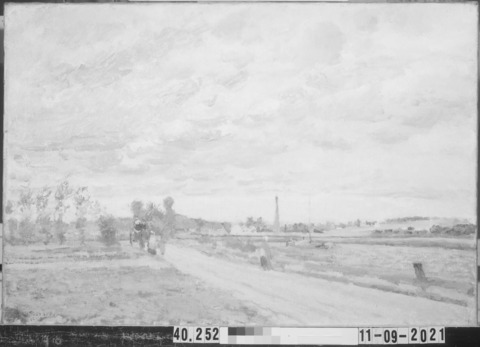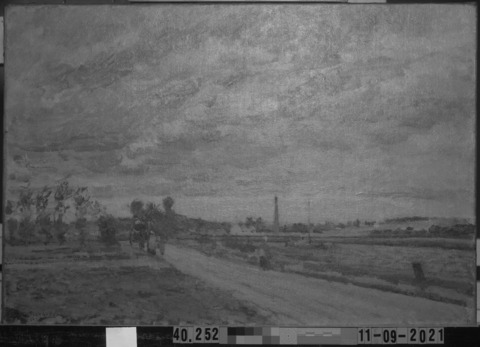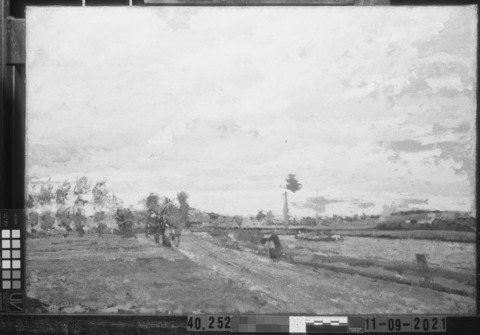Overview
Identification number: 40.252
Artist: Camille Pissarro
Title: The Banks of the Oise near Pontoise
Materials: Oil on canvas
Date of creation: 1873
Dimensions: 38.1 × 57.8 cm
Conservator/examiner: Alex Chipkin with contributions from Roxane Sperber, Gregory D. Smith, and Laura Mosteller
Examination completed: 2022
Distinguishing Marks
Front:
The artist’s signature and the date, “C. Pissarro. 1873” can be seen on the bottom left-hand corner of the painting (fig. 1). The inscription was written over the dried paint layers in a dark brown paint. Under the microscope, the paint used for the signature appears to be grainy and possibly containing very little binding medium. When it was applied to the textured paint surface, it adhered only to the peaks of the impasto, creating a broken-up appearance that contrasts with the smoothly painted signatures seen in his other paintings.
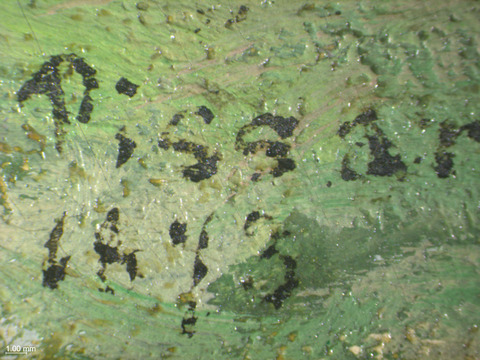
Back:
On the back, various numbers are inscribed both on paper labels and directly onto the stretcher bars (zoom in to see inscriptions on back, fig. 2). Since the back of the original canvas is covered with a lining canvas, no stamp from a supplier is visible. There are, however, two stamps from the import/export office in Paris, called Douane Centrale, on the lining canvas and stretcher bar seen on the lower right-hand side (fig. 3).
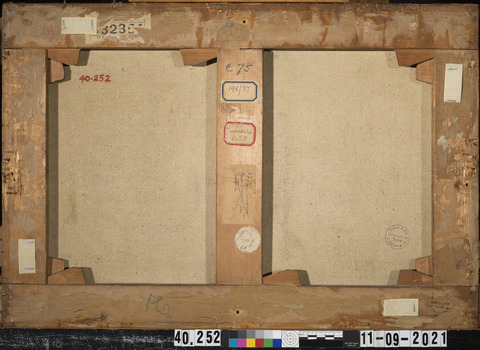
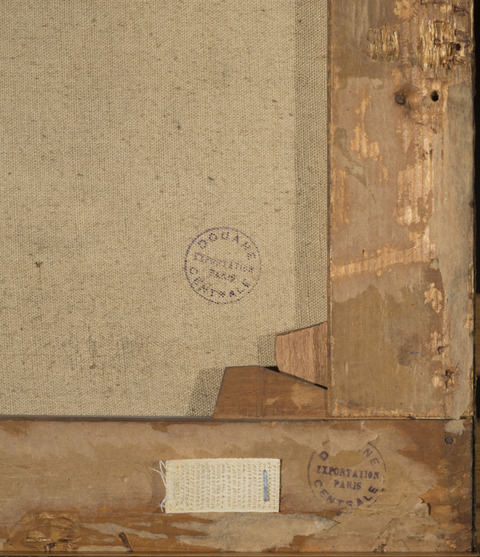
Historical Context
In this painting, Camille Pissarro depicted a rural scene with a factory in the distance, distinguished by a smokestack that rises above the horizon line, almost as tall as the row of trees on the left (fig. 4). Intermingled with the dramatic swirling clouds are white puffs of steam from a train passing through in the distance, heading towards the center of the picture plane from the right-hand side. A figure walks on the dirt path along the bank of the Oise River. Further up the road, a group of people recede into the distance. On the river is a small river barge, the mast of which rises as tall as the smokestack.
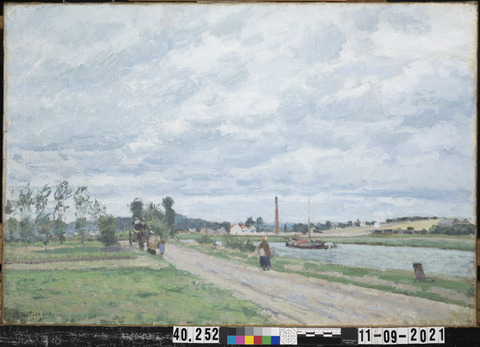
This vista is located in a region just outside of Paris, about 20 miles to the west, called Pontoise. Camille started painting in Pontoise along the Oise River in 1872, when he moved there after having briefly lived abroad in London during the Franco-Prussian War. He resided on the left bank at L’Hermitage until 1882 and painted 300 works while there.1 Pissarro painted a number of similar views featuring the various factories along the river. Many factories in the nineteenth century were established near bodies of water, which provided power to run the mills. The factory pictured in this painting is, appropriately, a paint factory near Épluches that had been recently built in 1870.2
This painting perhaps exemplifies what many writers of the period identified as the banlieue, an in-between space where the countryside ended and the city began. This was an area into which industrialization was slowly encroaching but had not yet taken over—a place between what was considered the fading old-world of rural life and the dawn of the new age of industry and scientific innovation.3 The word now refers to the outskirts of a city or a suburb. This painting can be seen as an illustration of this time of transition. In fact, it was at this time that Baron Haussmann was beginning to undertake his grand building projects, expanding Paris to the west toward areas like Pontoise.
In 1940, The Banks of the Oise near Pontoise by Camille Pissarro was acquired by the Indianapolis Museum of Art through the American art dealer Theodore Schempp (active from 1937 to 1950).4
Summary of Treatment History
No documentation has been retained of the conservation treatments of The Banks of the Oise Near Pontoise before it was acquired by the IMA. Physical evidence suggests that several interventions took place, including a relining. In a 1951 condition report, the painting is noted as having had a natural resin varnish coating. Surface dirt and moderate yellowing (likely referring to the varnish), as well as cracking on the vertical axis was noted by a conservator.5
A decade later, in 1961, another conservator noted that there was abrasion in the sky that had been overpainted, and that dirt was “trapped in the brush-markings.” At this time cleaning was undertaken with naphtha followed by a wet swab. This was probably intended to remove surface dirt and not the natural resin varnish coating that remained on the surface of the painting at that time. Two “straps” were added to hold the painting securely in the frame. A year later another condition assessment was made that noted that the condition was unchanged.
In 1964, it was observed that the inpainting was becoming dark, and the overall yellowing and imbibed dirt was disfiguring. It was recommended that cleaning be considered. Four years later, the record noted that the painting was cleaned of the old natural resin coating, and a synthetic Acryloid B72 varnish was applied. The frame was repaired and refitted at this time as well.
A 2005 examination report by conservator David Miller notes that the painting was glue lined. He mentions that residues of old, discolored natural resin varnish were visible in the interstices of the paint. He posits that Pissarro may have intended for the painting to have remained unvarnished, but that there was no evidence to support removing the coating at that time.6
Current Condition Summary
Overall, the painting is structurally stable. The work has been lined, and the canvas is taut and planar. There is craquelure visible throughout the sky, as is expected for a painting of this age. The ground and paint layers are well bound. The surface coating remains transparent and glossy, and the retouching has not yellowed.
Methods of Examination and Imaging
| Examination/Imaging | Analysis (no sample required) | Analysis (sample required) |
|---|---|---|
| Unaided eye | Dendrochronology | Microchemical analysis |
| Optical microscopy | Wood identification | Fiber ID |
| Incident light | Microchemical analysis | Cross-section sampling |
| Raking light | Thread count analysis | Dispersed pigment sample |
| Reflected/specular light | X-ray fluorescence spectroscopy (XRF) | Fourier-transform infrared spectroscopy (FTIR) |
| Transmitted light | Macro X-ray fluorescence scanning (MA-XRF) | Raman microspectroscopy |
| Ultraviolet-induced visible fluorescence (UV) | ||
| Infrared reflectography (IRR) | Gas chromatography–mass spectrometry (GC-MS) | |
| Infrared transmittography (IRT) | Scanning electron microscope -energy dispersive X-ray spectroscopy (SEM-EDS) | |
| Infrared luminescence | Other: | |
| X-radiography |
Technical Examination
Description of Support
The Banks of the Oise near Pontoise is painted on a linen canvas (untested) with a 26 × 24 thread count and is lined with canvas of a heavier weight.7 The canvas type is a number 10, a standardized size of canvas offered by suppliers in Britain and France during the nineteenth century. The measurements indicate a vertical landscape format that was oriented horizontally by the artist.8 Pinholes seen at each corner of the canvas indicate that Camille probably began this painting en plein air. Special double-sided pins called taquets en buis were used to separate multiple paintings from each other, keeping the freshly painted canvases from touching.9 The pinholes can be seen in the MA-XRF scan for calcium (indicated in yellow, in fig. 5), as well as in photomicrographs (figs. 6, 7).
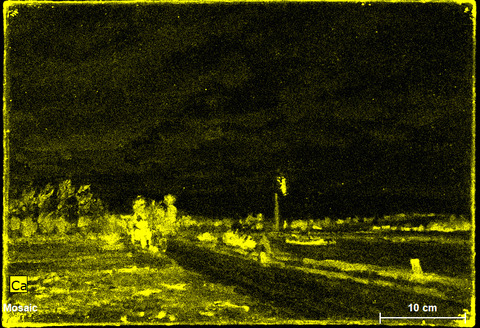
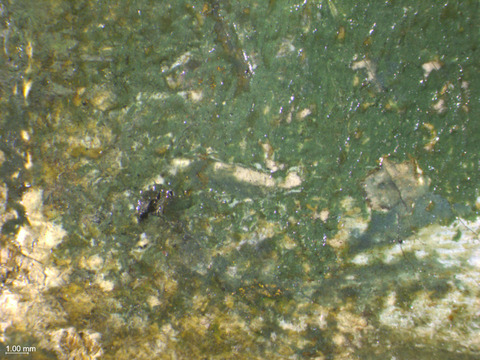
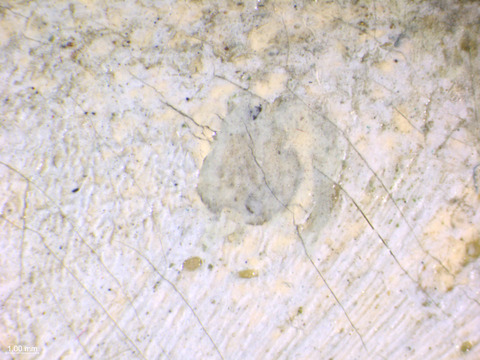
Auxiliary Support:
Original Not original Not able to discern None
The painting is mounted onto a five-member wooden stretcher with half lap joints at the center member and corners (see fig. 2). Conservator David Miller noted in a report from 2005 that the stretcher may be of French origin and possibly original. Because there is paper tape covering the stretcher bars, it is not possible to observe any marks from suppliers.
Attachment to Auxiliary Support:
There are 129 tacks attached in equally spaced pairs on the tacking margins.
Condition of Support
The support is stable and planar, and the tacking margins have remained intact. All eight stretcher keys are present and are not secured to the stretcher bars. There are remnants of brown paper tape on the stretcher bar members.
Description of Ground
Color:
Beige
Application:
The painting is primed with a double ground. This can be seen on the exposed edges of the painting under magnification (fig. 8).
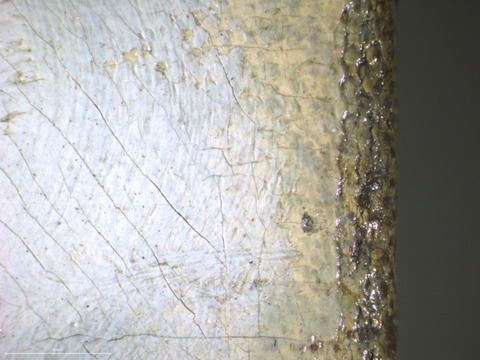
Character and Appearance (Does texture of support remain detectable/prominent?):
The texture of the canvas is observable through the ground layer.
Thickness:
The first layer is thinly applied and fills in the canvas weave. The priming layer extends over the tacking margins, which indicates that it was commercially applied by a colorman.10 The second ground layer is more thickly applied and does not continue over the tacking margins, suggesting the upper layer has been applied by the artist.
Materials/Binding Medium:
Detail MA-XRF scans of a section of the ground at the edge of the canvas show the composition of the two different priming layers. The presence of calcium mapped in the MA-XRF scan indicates that the lower layer is composed of chalk, or calcium carbonate (fig. 9). In this MA-XRF map, the white flecks on the left show the areas where the upper layers of paint have not completely filled the interstices of the canvas weave, leaving small areas of the lower ground layer exposed. FTIR analysis on 40.252 Sample c taken from the lower ground layer on the turnover edge identified some lead in the lower ground layer. The upper ground layer is composed mainly of lead white, as indicated by the MA-XRF scan for lead (fig. 10). In a cross section taken from the trees on the right-hand side, yellow pigment particles are visible in the second ground layer, which is why the upper ground layer appears beige (fig. 12).11 FTIR analysis on the medium of the first ground layer indicates that it is bound in linseed oil.12 The upper ground layer is likely bound in a drying oil as well, but this has not been tested.13
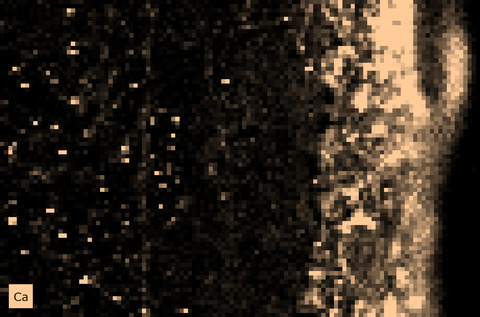
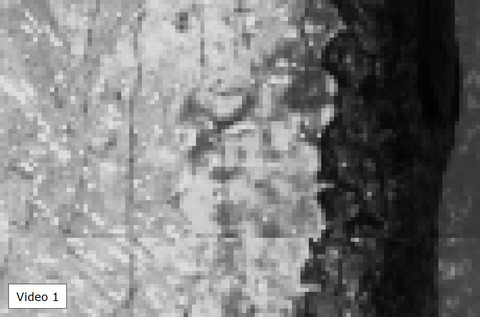
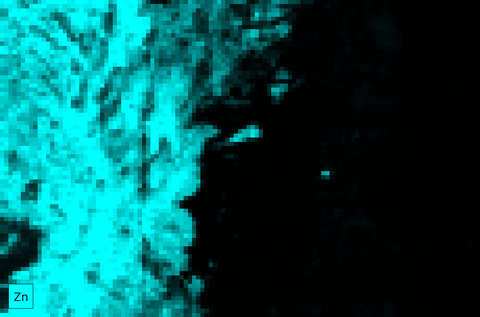
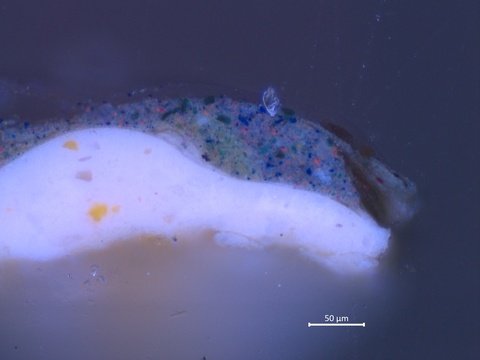
Sizing:
Likely gelatin (untested)
Condition of Ground
The ground layers are well bound and display no delamination from the support.
Description of Composition Planning
Methods of Analysis:
Surface observation (unaided or with magnification)
Infrared photography (IR)
X-radiography
Analysis Parameters:
| X-Ray equipment | GE Inspection Technologies Type: ERESCO 200MFR 3.1, Tube S/N: MIR 201E 58-2812, EN 12543: 1.0mm, Filter: 0.8mm Be + 2mm Al |
|---|---|
| KV: | 25 |
| mA: | 3.0 |
| Exposure time (s) | 90 |
| Distance from x-ray tube: | 36 inches |
| IR equipment and wavelength | Modified Nikon D610 camera with a Coastal Optics lens and X-nite 1000C filter |
Medium/Technique:
No underdrawing was detected in IR photography. However, as was his standard practice, Pissarro blocked out each element of the landscape with thin, flat swaths of color, leaving a narrow space of ground exposed between each element (see fig. 14 below).14 This can be seen in by the unaided eye in visible light, as well as under magnification. X-radiography (fig. 13) also shows the reserves left for the trees and thinner applications of paint between each element.
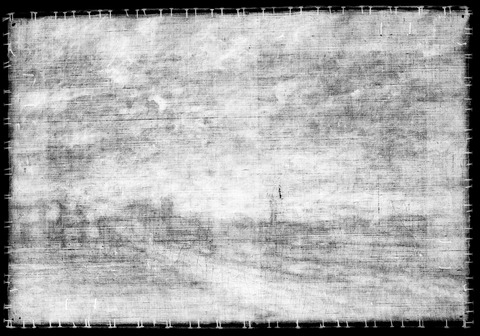
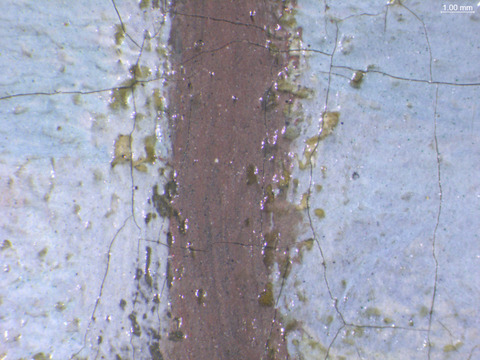
Description of Paint
Analyzed Observed
Application and Technique:
After Pissarro blocked in the colors of the initial composition, he then came back in to modulate the hues and add detail. This can be seen under magnification in visible light. When Pissarro returned to add detail and make changes, he filled in the spaces between the forms and softened some of the contours. For example, Pissarro painted over the tops of the trees and the peak of the pitched roof of one of the factory buildings with the same blue paint he had used to block in the sky (figs. 15, 16). This blue paint is also used to blot out parts of the mast of the river barge, perhaps to lessen its prominence in comparison to the smokestack to the left (fig. 17).
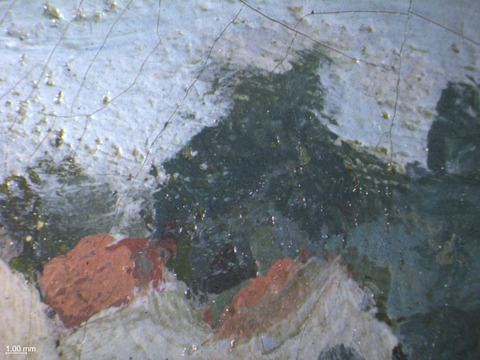
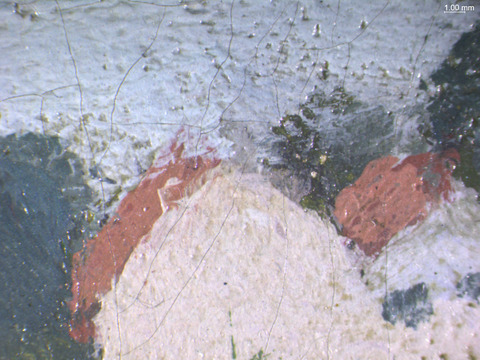
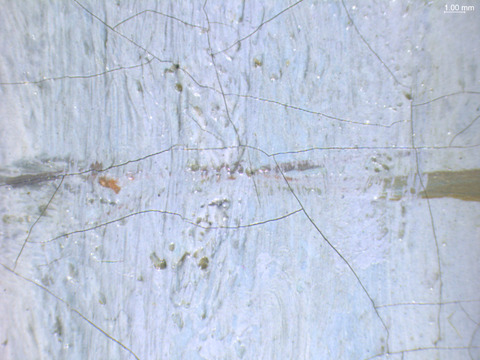
The sky was painted with a thin layer of stiff paint that has retained the brushstrokes. The paint has skipped over the interstices of the canvas weave, leaving areas of exposed ground (fig. 18). This can also be seen in the application of paint for the river below, where the surface looks quite craggy (fig. 19). There are also areas of the sky left unpainted. Pissarro utilized the white of the exposed priming layer as an easy way to modulate the tonality of the blue sky. The spaces between the clouds on the right-hand side successfully give the impression of being illuminated from behind by the sun.
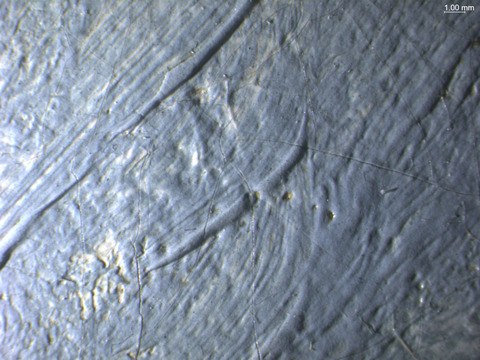
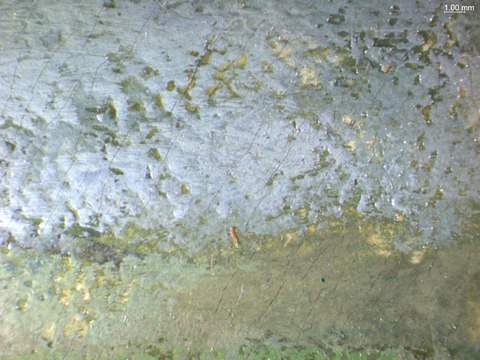
On the left-hand side of the painting, Pissarro economically represented a row of trees blowing in the wind with quick, summary strokes of green paint over the wet paint of the sky. The still-wet paint underneath was picked up with each brushstroke, producing soft edges. For the variation in color, Pissarro used two different greens (figs. 20, 21).
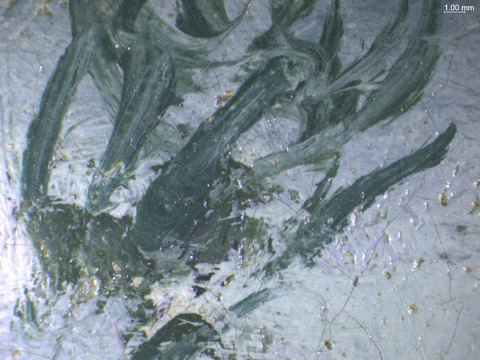
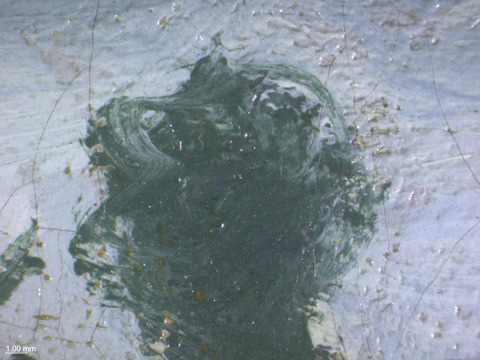
In order to work quickly, and not wait for each layer of paint to dry, Pissarro applied thick dabs of paint in some passages, loading his brush enough so that it did not pick up too much of the wet paint below. In this way he avoided the mixture of paint on the surface of the canvas even when painting wet-in-wet. This can be seen in the depiction of the group of figures receding into the distance, as well as in the steam puffing out of the train (figs. 22, 23).
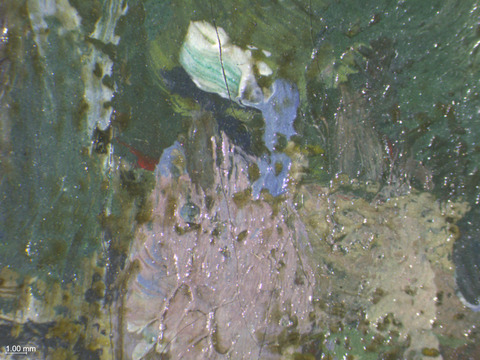
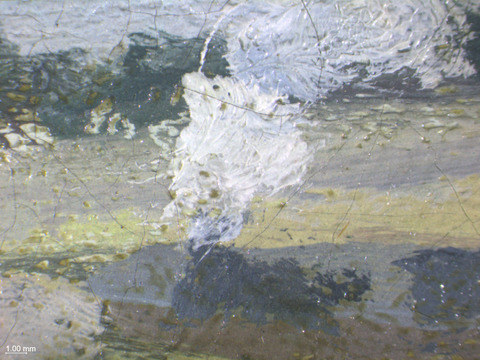
Painting Tools:
The oil paint was applied with brushes. The strokes suggest that the same size brush was used to paint the foreground objects as well as those in the background. It does seem, however, that the artist used a larger brush for the initial laying in of colors and smaller brushes for the subsequent layers, such as the serpentine strokes denoting the trees on the left-hand side.
Binding Media:
Oil paint (untested)
Color Palette:
For the blue sky, river, and skirt of the woman, synthetic ultramarine was used. This was confirmed with the use of Raman microspectroscopy.15 Pissarro used a great deal of zinc white in his paint mixtures for the landscape as well as in the blue mixture when he went back in to add detail and modify shapes on the horizon line, as confirmed in the MA-XRF scan for zinc (fig. 24).
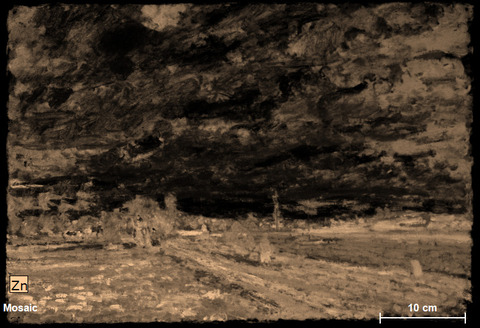
For the green passages in the landscape, Pissarro used emerald green, as indicated by the detection of copper and arsenic with MA-XRF scanning. This can be seen in the map below (fig. 25). The MA-XRF scan detected chromium in the green passages as well, indicative of viridian. This is a cool-toned green that was used for more shadowy areas as well as for foliage in the distance (fig. 26). In these passages, he used the traditional visual technique of atmospheric perspective in which more distant objects are painted with bluer hues. The use of two different green pigments can be seen clearly in the MA-XRF scan of the row of trees on the left-hand side: arsenic, indicative of the presence of emerald green, and chromium, indicative for the presence of viridian (fig. 27). The MA-XRF map for Hg indicates that vermilion was added to many of the green areas, presumably to reduce the saturation of the bright pigments (fig. 28).
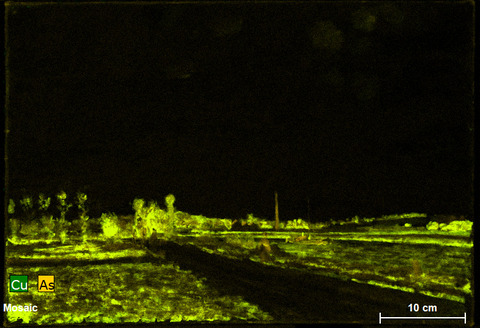
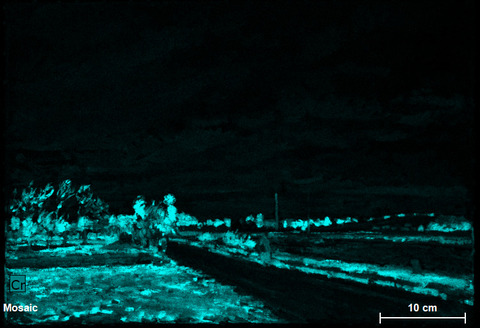
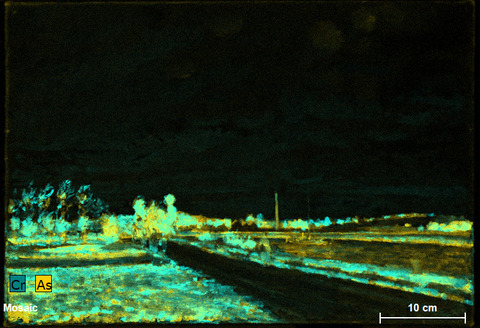
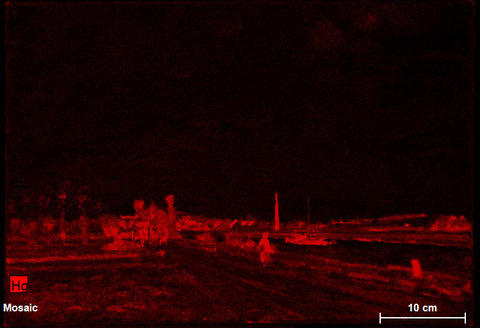
A MA-XRF scan of the single figure closer to the foreground shows that she was painted after the emerald green background had been laid in (fig. 29).
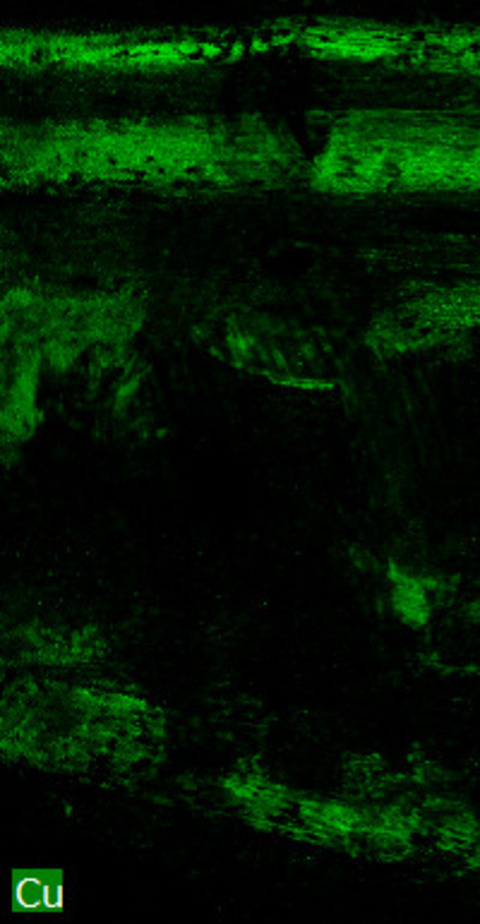
The MA-XRF scan detected iron and mercury in the brown overcoat, which is consistent with the use of an iron oxide mixed with vermilion (figs. 30, 31).
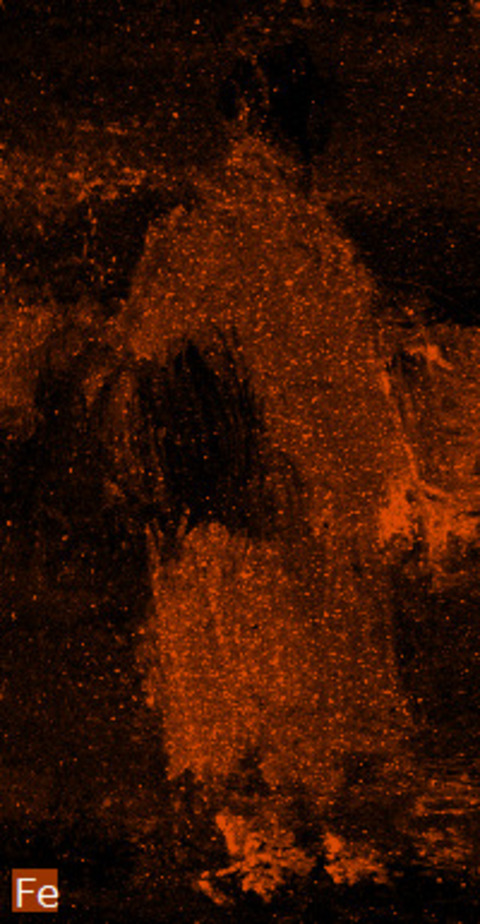
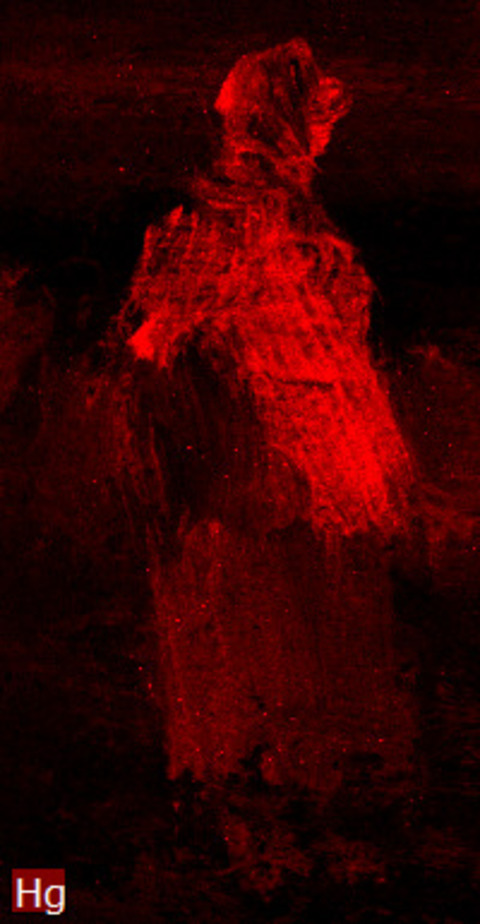
In addition to the French ultramarine detected with Raman spectroscopy, the MA-XRF scan detected zinc and chromium in the figure’s blue skirt (figs. 32, 33). This is indicative of a mixture containing zinc white and possibly viridian. According to the MA-XRF map of the Mα line for lead, the package the woman holds is painted with lead white (fig. 34). The detection of mercury and lead with MA-XRF in the headdress of the woman indicates that it was painted with vermilion into which a dab of lead white was added for the highlight (figs. 31, 34).
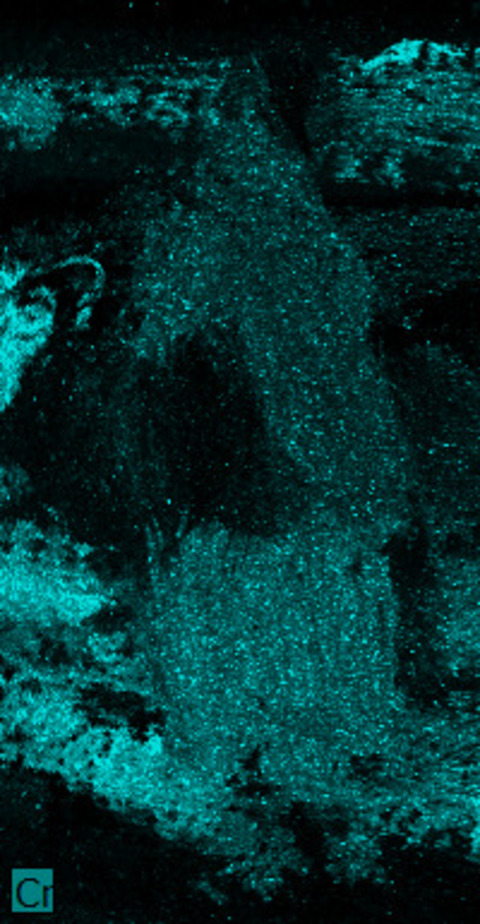
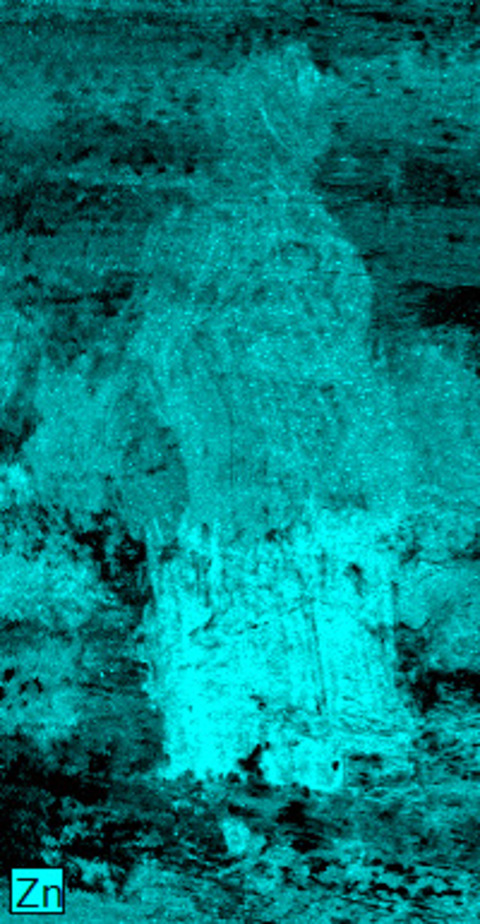
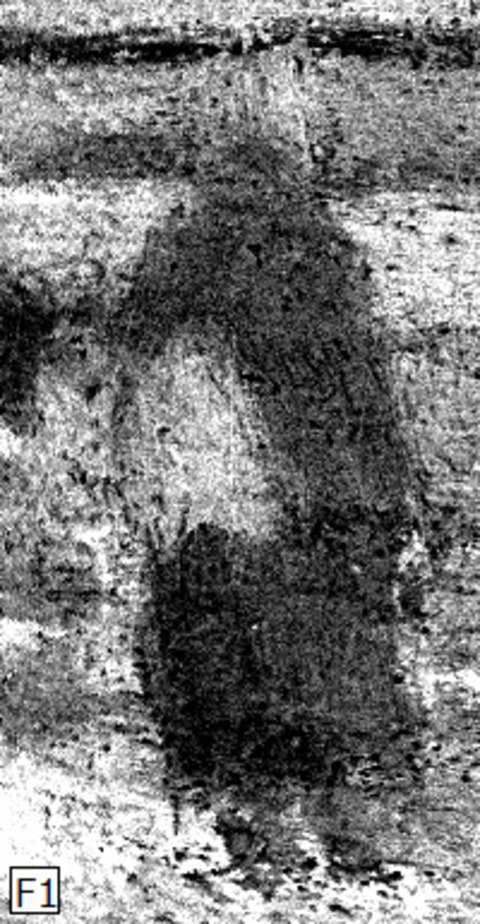
Condition of Paint
There are some small losses in the sky above the smokestack that have been inpainted. This can be seen in the UV image in the next section (fig. 37). The painting exhibits weave emphasis that likely occurred as a result of the lining process. This is not readily noticeable to the unaided eye in visible light, but it can be observed in the raking light image below (fig. 36).
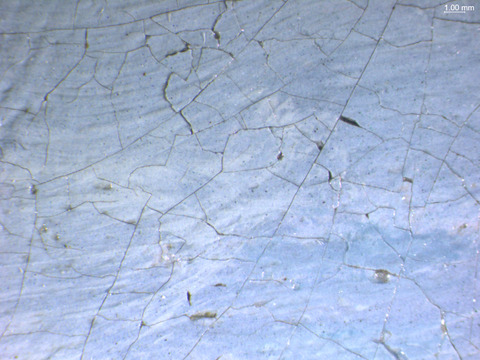
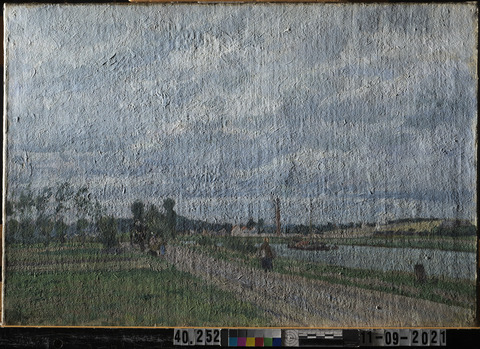
Description of Varnish/Surface Coating
Analyzed Observed Documented
| Type of Varnish | Application |
|---|---|
| Natural resin remnants in interstices | Brush applied |
| Synthetic resin/other | Brush applied |
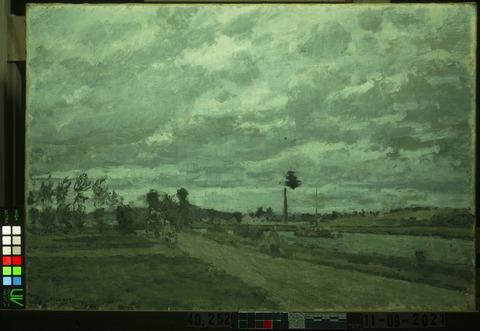
Condition of Varnish/Surface Coating
As stated in the Summary of Treatment History section, the coating is a synthetic varnish, Acryloid B72. The varnish remains glossy and has not yellowed. Under magnification, minor remnants of the prior discolored natural resin varnish can be seen in the interstices of the paint (fig. 38). As noted in the prior section, there is an area of retouching above the smokestack that is visible under UV irradiation (fig. 37).
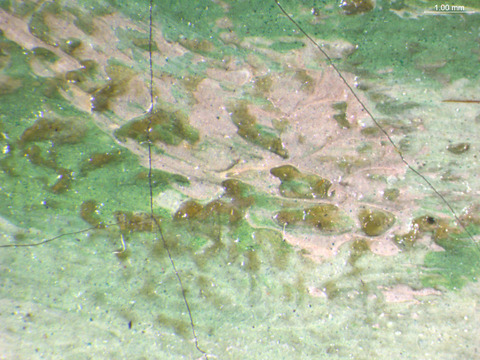
Description of Frame
Original/first frame
Period frame
Authenticity cannot be determined at this time/ further art historical research necessary
Reproduction frame (fabricated in the style of)
Replica frame (copy of an existing period frame)
Modern frame
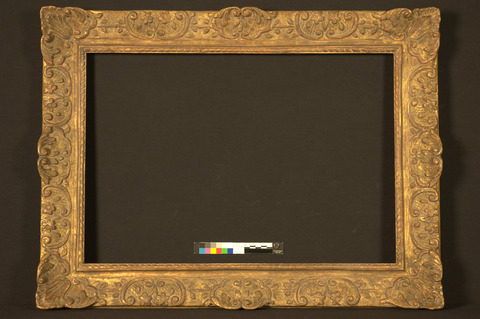
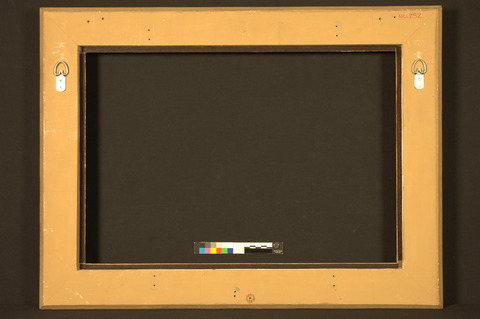
Frame Dimensions:
Outside dimensions: 51.66 × 69.85 × 6.03 cm
Rebate dimensions 38.58 × 56.04 × 1.58 cm
Sight size dimensions 54.14 × 36.83 cm
Frame molding rail width 9.53 cm
Distinguishing Marks:
None
Description of Molding/Profile:
The frame was selected by the Senior Paintings Conservator David Miller in approximately 2006 and custom made by APF Munn Master Framemakers of New York, New York.16 It is a modern reproduction in the style of a Louis XIV profile, constructed of a wood substrate with cast resin ornament that is gilded with an antiqued finish. The vendor catalog style is designated as #14-334-C with an ogee profile. The ornament comprises a rope twist sight edge and foliate corners and centers on a cross-hatched ground linked with C scrolls enclosing a dual-floral detail (fig. 39). The frame has mitered joins (fig. 40).
Condition of Frame
The frame is structurally secure and in very good aesthetic condition.
Notes
-
J. Pissarro and C. Durand-Ruel Snollaerts, Pissarro: Critical Catalogue of Paintings (Milan: Skira; Paris: Wildenstein Institute, 2005), 2:97. ↩︎
-
The factory was owned by Camille Arnoul and located near another, larger factory seen in many of Pissarro’s paintings from Pontoise called the J. Châlon factory. See J. Pissarro and C. Durand-Ruel Snollaerts, Pissarro: Critical Catalogue of Paintings (Milan: Skira; Paris: Wildenstein Institute, 2005), 2:218, 239. ↩︎
-
T.J. Clark, The Painting of Modern Life: Paris in the Art of Manet and his Followers (Princeton, NJ: Princeton University Press, 1984), 25–30. ↩︎
-
See letter from Theodore Schempp to Robert and Traude Hensel (?) in “Proposal, Assessment, and Approval,” File 40.252, Curatorial Department Files, Indianapolis Museum of Art at Newfields.
On Schempp, see https://www.metmuseum.org/art/libraries-and-research-centers/leonard-lauder-research-center/research-resources/the-modern-art-index-project/schempp. See also the letter labelled “Jeff Hist,” File 40.252, 12 January 1970, Curatorial Department Files, Indianapolis Museum of Art at Newfields. In a correspondence between Schempp and Robert and Traude (presumably Robert Swain and Traude Hensel of the Robert and Traude Hensel Collection), Schempp mentions, “I feel quite proud in having sold many of the 20th (and 19th) Century French paintings in the collection. I wonder if you realize how many? The earliest is a '71 (1871 I think, or 1870) Pissarro 40.252…” ↩︎
-
See "RDB" or "RB," condition report, 40.252, 1951, Conservation Department Files, Indianapolis Museum of Art at Newfields. ↩︎
-
See David Miller, condition report, 40.252, 2005, Conservation Department Files, Indianapolis Museum of Art at Newfields. ↩︎
-
D.H. Johnson, “Thread Count Report: The Banks of the Oise near Pontoise Camille Pissarro 1873 (PS303/40.252) from the Indianapolis Museum of Art,” 2021, Conservation Department Files, Indianapolis Museum of Art at Newfields. ↩︎
-
Ascertained from Lefranc’s “Table of Standardized Canvas Formats” reproduced in A. Callen, Techniques of the Impressionists (London: Chartwell Books, 1993), 59. ↩︎
-
A. Callen, The Work of Art: Plein Air Painting and Artistic Identity in Nineteenth-Century France (London: Reaktion Books, 2014). ↩︎
-
Commercially primed canvases usually do not display any raw, unprimed canvas at the turnover edges. This is because the colorman, or artist supplier, would prepare canvases in batches. A length of fabric from a bolt would be stretched onto a large frame, sized, and then primed with a ground layer. The fabric was then ready to be cut down into smaller pieces which could be sold as-is or stretched onto stretchers. See D. Bomford et al., Art in the Making: Impressionism (London: National Gallery in association with Yale University Press, 1990), 49. ↩︎
-
The first ground layer is missing from 40.252 Sample a. ↩︎
-
FTIR conducted on 40.252 Sample C, a sample of the lower ground layer, treated with 10% hydrofluoric acid. ↩︎
-
See L. Gutierrez and A. Burnstock, “Technical Examination of Works by Camille and Lucien Pissarro from the Courtauld Gallery,” ArtMatters 5 (2013): 16 and D. Bomford et al., Art in the Making: Impressionism (London: National Gallery in association with Yale University Press, 1990). ↩︎
-
D. Bomford et al., Art in the Making: Impressionism (London: National Gallery in association with Yale University Press, 1990), 136–138. ↩︎
-
Completed by Roxane Sperber and Gregory D. Smith in June 2021. ↩︎
-
Senior Curator Ellen Lee also likely had a hand in this decision. ↩︎
Additional Images




